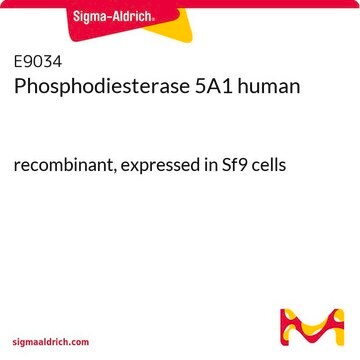E1131
Exonuclease III from Escherichia coli BE25 /psGR3
buffered aqueous glycerol solution
Sign Into View Organizational & Contract Pricing
All Photos(1)
About This Item
Recommended Products
grade
Molecular Biology
for molecular biology
form
buffered aqueous glycerol solution
mol wt
28 kDa
UniProt accession no.
storage temp.
−20°C
Gene Information
Escherichia coli K12 ... xthA(946254)
General description
A 3′→5′ exonuclease which catalyzes the removal of mononucleotides from the 3′-end of dsDNA. The enzyme also has apurinic and apyrimidinic endonuclease, 3′-DNA phosphatase, and RNase H activities. Activity is strongly dependent on temperature, salt concentration, and the ratio of enzyme to DNA, therefore reaction conditions must be optimized for specific applications.
Application
Suitable for:
- Production of strand specific probes
- Preparation of single stranded templates for Sanger dideoxy sequencing
- Site directed mutagenesis
Components
Exonuclease III is supplied as a solution in 5 mM potassium phosphate (pH 6.5), 200 mM KCl, 0.05 mM EDTA, 5 mM 2-mercaptoethanol, 200 μg/ml BSA, and 50% glycerol.
Unit Definition
One unit releases 1 nmole of acid-soluble nucleotides from sonicated calf thymus DNA in 30 min at 37 °C.
related product
Product No.
Description
Pricing
Glutathione S-Transferase from E. coli, recombinant, expressed in E. coli, buffered aqueous solution
Ribonuclease A from bovine pancreas, for molecular biology, ≥70 Kunitz units/mg protein, lyophilized
Storage Class Code
12 - Non Combustible Liquids
WGK
WGK 3
Flash Point(F)
Not applicable
Flash Point(C)
Not applicable
Personal Protective Equipment
dust mask type N95 (US), Eyeshields, Gloves
Choose from one of the most recent versions:
Already Own This Product?
Find documentation for the products that you have recently purchased in the Document Library.
Ying Chen et al.
Chemical communications (Cambridge, England), 47(48), 12798-12800 (2011-11-15)
The presence of exonuclease III leads to direct recycling and reuse of the target DNA, which in turn results in substantial signal amplification for highly sensitive, label-free impedimetric detection of specific DNA sequences.
Peng Hu et al.
Biosensors & bioelectronics, 34(1), 83-87 (2012-03-03)
We report here a graphene oxide (GO)-based fluorescent aptasensor for adenosine detection by employing exonuclease III (Exo III) as a signal amplifying element. In the absence of adenosine, the adenosine aptamers hybridized with the complementary DNA (cDNA), and the Exo
Sai Bi et al.
Chemical communications (Cambridge, England), 48(7), 1018-1020 (2011-12-07)
The network consisting of three kinds of unlabeled stem-loop DNA molecular beacons (MBs) is activated by target DNA in the presence of exonuclease-III (Exo-III), achieving the concept of exonuclease-assisted cascaded recycling amplification (Exo-CRA) for DNA detection with a wide dynamic
L H Guo et al.
Nucleic acids research, 10(6), 2065-2084 (1982-03-25)
We describe improve enzymatic methods for sequencing method for sequencing DNA. They are based on partial digestion of duplex DNA with exonuclease III to produce DNA molecules with 3' ends shortened to varying lengths, followed by repair synthesis to extend
Xiaofeng Wei et al.
Chemical communications (Cambridge, England), 48(49), 6184-6186 (2012-05-17)
Based on the specific folic acid-folate receptor (FA-FR) interaction, macromolecular FR can bind with FA-linked DNA-small molecule chimeras, which can prevent enzymolysis by exonuclease III (Exo III), enabling a novel fluorescence biosensor for FR to be developed using quinaldine red
Our team of scientists has experience in all areas of research including Life Science, Material Science, Chemical Synthesis, Chromatography, Analytical and many others.
Contact Technical Service






